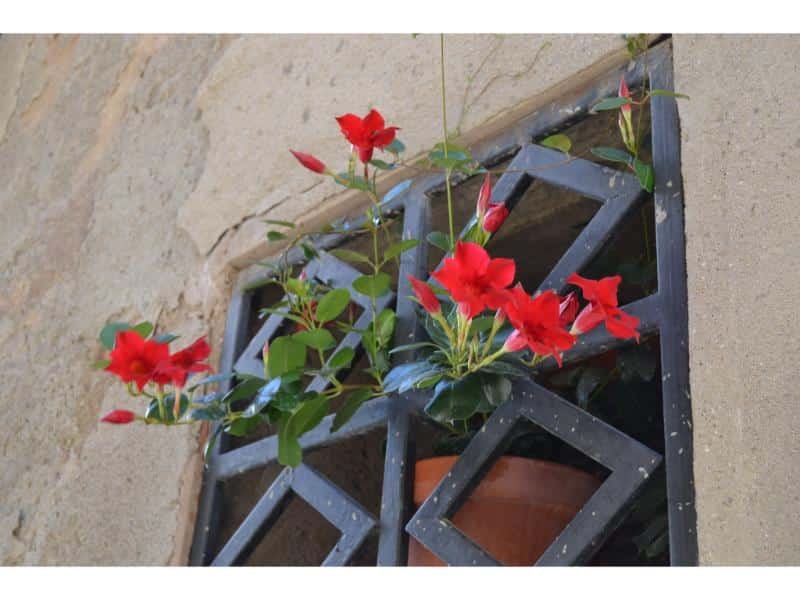Rio Dipladenia is a beloved warm-weather flowering plant that brings vibrant color and visual interest to gardens and patio containers with its profuse blooms during the growing season.
However, getting this tropical plant to consistently bloom each year can be a challenge in colder climates where it must be overwintered indoors. Proper care including fertilization, watering, and pruning is key to encouraging annual flowering.
Table of Contents
Overwintering Rio Dipladenia for Reblooming
Many gardeners struggle with getting their Rio Dipladenia to bloom year after year after bringing it inside for winter dormancy. The plant often loses blooms and foliage over the winter months, which is to be expected. The key is to keep the plant alive through winter so that it can leaf out and rebloom again in spring.
Overwintering experts recommend:
- Placing the plant in a sunny indoor location near a window
- Maintaining consistent temperatures above 45 degrees Fahrenheit
- Watering only when the top few inches of soil become dry to the touch to prevent root rot
- Expecting leaf and bloom loss as part of the plant’s natural winter dormancy
Resist the urge to cut back, prune, or overwater during winter dormancy as this can further stress the plant. The goal is simply to keep the root system and plant crown alive until spring growth resumes. As long as the plant remains healthy, it should leaf out and bloom again in spring.
“Some foliage may die, but your Rios should produce new foliage in spring.”
Spring Recovery and Preparing for Rebloom
Once warmer spring weather returns, a successfully overwintered Rio Dipladenia will begin sending out new foliage and shoots. At this point, the plant needs a little TLC to encourage lush growth and prepare for a season of abundant blooms:
Fertilization
- Apply a bloom-boosting fertilizer like an 18-6-12 formula rather than standard Miracle-Gro type fertilizers
- “Miracle Grow promotes greenery at the expense of blooms/fruit.”
- The higher phosphorus middle number aids flowering and fruit production
- Time applications for early spring and mid-summer
- Slow-release granular fertilizer is recommended
Watering
- Increase watering as the plant enters the growth phase
- Water thoroughly, allowing the soil to slightly dry between waterings
Pruning
- Pruning is not generally recommended on Rio Dipladenia
- Allow new shoots and growth to develop naturally
“If you read through the information in the link, they do not mention cutting it back but treating it like a houseplant.”
Caring for Rio Dipladenia In-Season
Once established in late spring, Rio Dipladenia requires basic care to encourage continual blooming throughout the warm season:
Sunlight
- Place plant in a location receiving full sun for at least 6 hours per day
- The morning sun is ideal
- Insufficient sunlight can inhibit prolific flowering
Watering
- Water when the top few inches of soil become dry
- Take care not to over water
- Good drainage is important to prevent root rot
Temperature
- Maintain above 60 degrees Fahrenheit
- Can withstand high heat as long as soil moisture is maintained
Deadheading
- Remove spent blooms to encourage new buds
- Clip back to the first set of healthy leaves
Staking
- Add stakes and ties to support new floppy growth if needed
Inspector for pests
- Check regularly for common insects like aphids or whiteflies
- Treat immediately to avoid population explosions
“Dipladenias only need watering when the top 5 cm (2 inches) of soil begin to dry.”
Preparing for Winter Dormancy Again
As summer ends and cool weather sets in, Rio Dipladenia will begin to slow down and prepare for winter dormancy once again. To help the plant successfully overwinter a second time:
Timing
- Bring the plant indoors before night temperatures drop below 45 degrees Fahrenheit
Location
- Place in a sunny indoor location near the window
Watering
- Reduce watering frequency, allowing soil to slightly dry out between waterings
- Avoid excess moisture
Temperature
- Maintain temperatures above 45 degrees Fahrenheit
- Stop fertilization during winter
Pruning
- Do not cut back or prune plants for winter dormancy
- Foliage loss is normal
The steps for overwintering are very similar for a Rio Dipladenia that has gone through summer dormancy before. Follow the same guidelines for providing the right environment to keep the plant healthy and alive so it can leaf out and rebloom beautifully in spring.
Troubleshooting Lack of Blooms
If a previously flowering Rio Dipladenia fails to bloom the following season, there are a few key things to troubleshoot after ruling out winter damage:
Fertilization
- Use a fertilizer with higher phosphorus to promote bud development but don’t overdo it as it can have a reverse effect as well.
- Ex: 18-6-12 ratio
- Apply early spring and midsummer
Sunlight
- Ensure the plant receives at least 6 hours of direct sun per day
- Lack of adequate sunlight can prevent flowering
Pruning
- Do not cut back hard in spring if blooms are desired
- Pruning removes potential flowering stems
Age of soil
- Repot in fresh soil every 2-3 years
- Old compacted soil can inhibit flowering
Checking on these common issues can help diagnose why a healthy Rio Dipladenia might not be blooming as expected. Adjust care as needed to support prolific flowers season after season.
Continual Seasonal Enjoyment
While Rio Dipladenia does require some specialized care to encourage yearly blooming after its winter dormancy indoors, the beauty and enjoyment it provides in garden beds and patio containers during the warmer months makes it worth the extra effort.
Following best practices for overwintering, spring revival, in-season maintenance, and fall preparation can allow for successful continual seasonal flowering. Give this tropical plant what it needs, and it will give you vibrant color summer after summer.

Gardening is my passion and growing plants indoors has always been a stress relief for me. Grow a banana tree in my apartment once (although failed to produce bananas).







